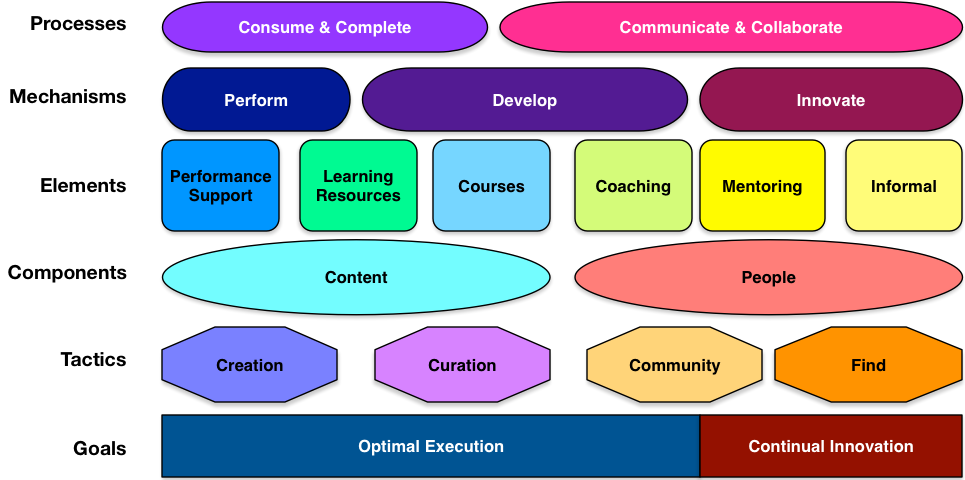One of the keys to the L&D revolution is recognizing the full performance ecosystem and the ways technology can support performance and development. I’ve tried to represent and share my thinking via diagrams (including here, here, and here). Prompted by a recent conversation, it was time to revisit the representation.
 Here, I’m layering on several different ways to think about the goals, elements, etc. (Given that this is an initial version, I’m kind of haphazard about labels like mechanisms, components, etc.) To start, as I continually argue, at the bottom it’s about coupling optimal execution with continual innovation. We need to do well those things we know we need to do, and then we need to continually improve. I think that more and more of the optimal execution is getting automated.
Here, I’m layering on several different ways to think about the goals, elements, etc. (Given that this is an initial version, I’m kind of haphazard about labels like mechanisms, components, etc.) To start, as I continually argue, at the bottom it’s about coupling optimal execution with continual innovation. We need to do well those things we know we need to do, and then we need to continually improve. I think that more and more of the optimal execution is getting automated.
On top of that, we have components – content and people – and the tactics to leverage them. We create or curate content (curation over creation!), and we develop relationships through community or find appropriate expertise through recommendations or search. The goal is to have the right content and the right people ‘to hand’ to work with.
We develop content elements like performance support to support performing in the moment, and learning resources for self-directed learning over time. We also use courses, whether individual or collaborative, to develop people (particularly when they’re novices). I’d put courses to the left and performance support to the right (above content) if we were talking about developing people (as I have here). So, for novices we first use courses, then practitioners need resources and coaching, and experts need interaction. However, performance support is on one side on a continuum of mechanisms from performing, to developing, to innovation. That’s what I’ve captured here.
Similarly, we use social elements like coaching, mentoring, and informal learning to develop ourselves and our organizations over time. We use processes like consuming and completing to execute. Then we develop our ability to execute and the continue to learn through communicating and collaborating.
There are lots of ways to represent the ecosystem, and given that elaboration theory tells us multiple representations help, here’s another stab. There are lots of elements to consider and fine tune, but I like to share my thinking to help it develop! Overall, however, the opportunity is the chance to be contributing to organizational success in systematic and valuable ways. And that, I’ll suggest, is valuable. I welcome your thoughts.
Interesting depiction. I agree that multiple representations from different perspectives bring a more comprehensive, clearer picture of the ecosystem.
I wonder where you see Competency Modeling (defining skills, knowledge, behavior for a specific role) in this picture?
James, I see competency modeling falling under formal learning. That is, we use such models to define what we should be curating or creating. Increasingly, however, I think it’s more work than makes sense (see an old/new picture of L&D activities here). Pretty soon, I reckon, anything that can be so well described in a competency model will be automated. And other stuff will be too fluid to define before it’s out of date.
Two other thoughts: competency modeling needs to design backwards to separate out what’s in the head versus what’s in the world. I’d also like to devolve responsibility to the communities that are around those roles and skills to maintain their own competency definitions. Thanks for the inquiry.
Nice model! Where would you put the necessary evil of compliance training? I can’t place it since it’s not performance and not development. It’s more of “we have your skills/knowledge documented for when FDA comes to visit”.
Or maybe we’re thinking about it from the wrong perspective? If one were to analyze compliance training from a design thinking perspective, maybe there shouldn’t be anything called “compliance training” but rather “Our Service Reps aren’t allowed to service our machines unless we have documented proof of their knowledge and skills. How do we solve that the most efficiently?” The solution might be something completely different than “train them and document the fact”.
Henrik, thanks for the question. I think when compliance training is CYA for legality (e.g. “we gave him sexual harassment training, so when he did it he’s a bad person, we’re a good company”), it’s not on this diagram. When you truly want to ensure new responses are there, then it fits under courses and performance. And your rethink is spot on: see the ‘design backwards’ reply I wrote to James’ comment.